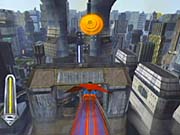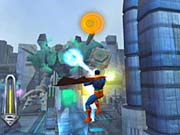Not to be confused with the recently released PlayStation 2 Superman game, Superman: The Man of Steel is an entirely new adventure--developed by an entirely different company--that adheres closely to recent events transpiring in the comic book as opposed to the cartoon series. Yet, The Man of Steel shares many of the same problematic traits of its PlayStation 2 counterpart, including poor collision detection, repetitive missions, and a somewhat imprecise lock-on feature that can make certain situations irritating, especially when the clock is ticking. But even with these drawbacks, The Man of Steel is largely successful in harnessing the essence of the comic book by conveying a sense of urgency and by giving Superman enormous environments to roam around as well as plenty of opportunities to use each of his unique powers.

Superman: The Man of Steel continues the storyline introduced in the comic book series, in which Metropolis had been "upgraded" as a result of a plot hatched by Braniac 13 and Superman's longtime adversary Lex Luthor. Braniac 13 eventually returns to Metropolis to harness the nanobots flowing through the city to construct a gargantuan version of itself in the middle of the city. Naturally, Superman is called into action, and in the process of attempting to defeat Braniac 13, he meets up with a few other villains and heroes that have appeared in the Superman comics over the past several years. The story unfolds through cutscenes that aren't all that visually impressive, but you can expect to hear some typical, overly heroic Superman dialogue supplemented by some decent voice acting.
These cutscenes also lead to new missions, in which Superman has to use most, if not all, of his special powers, including superstrength, heat vision, cold breath, and X-ray vision. Superman can also use supersight to focus in on a specific object, and he has superhearing, which takes the form of an arrow indicator at the top of the screen that either leads you to the next objective within a mission or to where the closest enemy is located. The Man of Steel functions well in getting you to use all of Superman's powers, especially when fighting various types of enemies, because each is susceptible to different powers. For example, one type of enemy can be destroyed only by heat vision, while another can be defeated only with Superman's cold breath. Even if Superman's powers don't kill the enemy, you can still use many of them in combination with each other against various foes, and you'll have to do so later in the game when the enemy count dramatically increases.
Not all of the missions in Superman require you to defeat some sort of enemy. In some situations, you might have to put out a series of fires or disarm bombs across Metropolis using cold breath or rescue civilians and relocate them to a safe area. Later in the game, Superman will even have to lift enormous objects and move them into new areas, and what makes this aspect of the game specifically interesting is that these heavy objects actually feel heavy, and Superman becomes a little more difficult to control, almost as if he's on ice. It seems a little awkward at first, and you'll undoubtedly have trouble getting these objects into the proper area, but once you get a feel for the controls and how to manipulate both the left and right analog stick, it becomes much less of a problem. Missions that occur later in the game require Superman to use his X-ray vision to peer inside relatively small objects or beneath the ground to search for danger. Some of these missions are timed or involve some sort of structural life meter for buildings, giving an excellent sense of urgency that a superhero would almost always have.
However, The Man of Steel runs into the trap where even though the environments change, the missions stay the same. Superman's quest to beat Braniac 13 takes him throughout the enormous city of Metropolis to Warworld and even space. But no matter which part of the universe Superman seems to be in, he's always putting out fires, fighting groups of enemies before destroying their generators (the devices that they spawn from), disarming bombs, or moving large objects. Occasionally, the game does a good job of adding a little variation by using the same objectives under different circumstances, but even so, undertaking similar missions throughout the entire game starts to wear thin.
There are also some secondary problems that are prevalent throughout each mission. While the default controls are actually quite easy to use for maneuvering Superman around the screen, the lock-on system can be somewhat problematic simply because it doesn't always lock onto the enemy that appears in your line of sight, so you really have to move in close and risk receiving damage from the enemy. In addition, the collision detection is really off in some spots. Superman bounces around like a Ping-Pong ball whenever you're flying in close quarters or near the ground and happen to touch one of the surfaces, which can cause some trouble in the missions that must be completed in a certain amount of time.

Thankfully, Superman won't actually have to fly through too many tight spots, because the environments in the game are absolutely massive. They're also quite detailed, for the most part. The draw distance in Metropolis is pretty amazing, and you'll be able to see all sorts of detail in the city ranging from cars flying around to reflective surfaces on some of the buildings. Other environments, such as Warworld, have similar characteristics. However, aside from some of the boss characters, the character modeling is pretty bad--Superman and many other characters and objects in the game look incredibly blocky, and animations can be a little choppy at times. The frame rate remains solid throughout most of the game, even with several enemies onscreen at once.
The sound in The Man of Steel is pretty standard for a Superman game. The dialogue is typical of something you might hear in a Superman film, and the voice acting is fairly convincing, though there are times when Superman sounds like a mindless superhero, along the lines of The Tick. Interestingly, the music is quite similar to that of the cartoon series, and it fits in well with the action.
Fans of Superman will have fun flying through Metropolis, using Superman's different powers to take out enemies or to save citizens, while unlocking some nice bonuses, such as additional costumes for Superman. But ultimately, Superman: The Man of Steel isn't a game for everyone, and the repetitive mission structure will more than likely deter all but the Superman faithful.